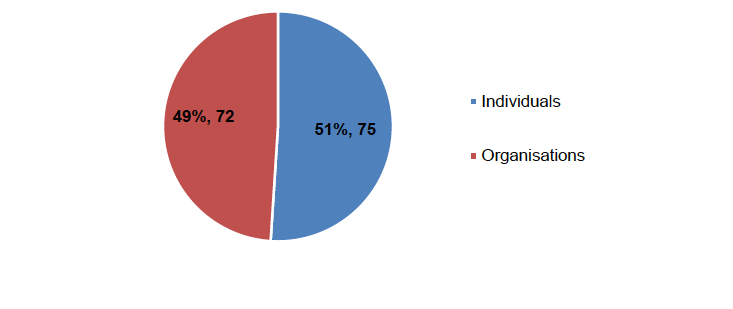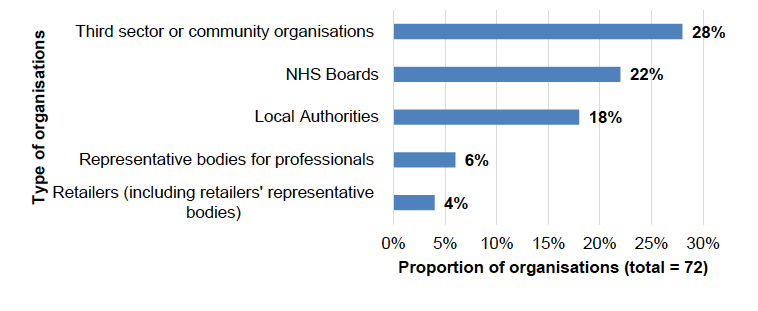Welfare Foods: consultation report
This consultation on meeting the needs of children and families in Scotland was published in April 2018 and invited views on our approach to Welfare Foods following the devolution through the Scotland Act 2016.
Introduction
Welfare Foods are a targeted package of support for pregnant women and young children to access a healthy diet. These include Healthy Start Vouchers and vitamins as well as a Nursery Milk Scheme. The powers over Welfare Foods have been devolved to the Scottish Government under the Scotland Act 2016.
The Scottish Government have set out their proposals for the devolved Welfare Foods programme in the consultation document 'Welfare Foods - a consultation on meeting the needs of children and families in Scotland' published in April 2018 (hereafter referred to as 'the consultation document'). [1] The consultation invited respondents' views on these proposals through 11 open-ended questions.
The proposals involve, firstly, integrating the former UK Healthy Start Vouchers into a new Best Start Grant system for eligible families. Within this, it is intended that the vouchers will be replaced by a Best Start Foods payment, distributed through a new smartcard system. The first part of the consultation (Qs 1 – 7) sought respondents' views on: how to increase awareness and uptake of Best Start Foods; the new smartcard system; how to work with retailers and others to improve families' diet and nutrition; and whether eligibility for children's vitamins should be linked to eligibility for Best Start Foods.
Secondly, the consultation document sets out proposals to continue the provision of free milk, and potentially adding a healthy snack, alongside a free meal to all children in funded Early Learning and Childcare ( ELC) provision from 2020. The second part of the consultation (Qs 8 – 11) sought respondents' views on these proposals. It also invited views on if and how the provision of free milk and healthy snacks could be extended to non-funded ELC provision.
1.1 Who responded to the consultation
A total of 147 respondents completed the consultation. Most of the responses were completed through Citizen Space. However, 10 individuals expressed views on the proposals through social media, and these have also been included in the analysis. As Figure 1 shows, there was a fairly even split between responses from individuals (75) and from organisations (72).
Figure 1 – The number of individuals and organisations that responded to the consultation
There was an almost even split between individual and organisational responses to the consultation

A majority of individual responses (58%) were uncategorised, but there were also individual responses from: medical or healthcare professionals (21%); parents or carers (5%); and childminders (4%).
As Figure 2 shows, organisational responses included responses from: third sector or community organisations (28%); NHS Boards (22%); Local Authorities (18%); Representative bodies for professionals (6%); and retailers including retailers' representative bodies (4%). [2]
Figure 2 – The most common types of organisations that responded
Third sector or community organisations and NHS organisations were most prevalent among organisational responses

1.2 Methodology
Responses to the open-ended questions were analysed thematically and qualitatively, but the frequency of themes was recorded to gain a sense of their prevalence across respondents. Whilst not exact, broad frequencies are indicated throughout the text using the following key:
- 'Few' means between 5 and 9%
- 'Some' means between 10 and 19%
- 'Many' means between 20 and 49%
- 'Most' or 'majority' means 50 to 74%
- 'Large majority' or 'broad agreement' means 75 to 89%
- 'Consensus' means 90% or higher.
Questions 7 to 11, however, did lend themselves to more precise quantification, given that they invited respondents to explicitly express agreement or disagreement. Therefore, in addition to analysing these responses qualitatively, it was recorded whether respondents agreed, disagreed or held unclear views about the proposal. Following this, the extent of agreement and disagreement to the proposals in these questions has been quantified and reported. [3]
This report is structured as follows:
- Chapter 2 summarises respondents' views on how to increase the awareness and uptake of Best Start Foods
- Chapter 3 covers respondents' views on the smartcard system
- Chapter 4 reports suggestions for a programme to support families establish healthy eating patterns
- Chapter 5 summarises views on the eligibility criteria for Healthy Vitamins
- Chapter 6 discusses respondents' views on the provision of milk and healthy snacks to all children receiving funded ELC entitlement.
- Chapter 7 discusses respondents' views on the provision of milk and healthy snacks to children not receiving funded ELC entitlement
- Chapter 8 concludes by highlighting the main messages that have emerged from an analysis of responses to the consultation.
Contact
There is a problem
Thanks for your feedback